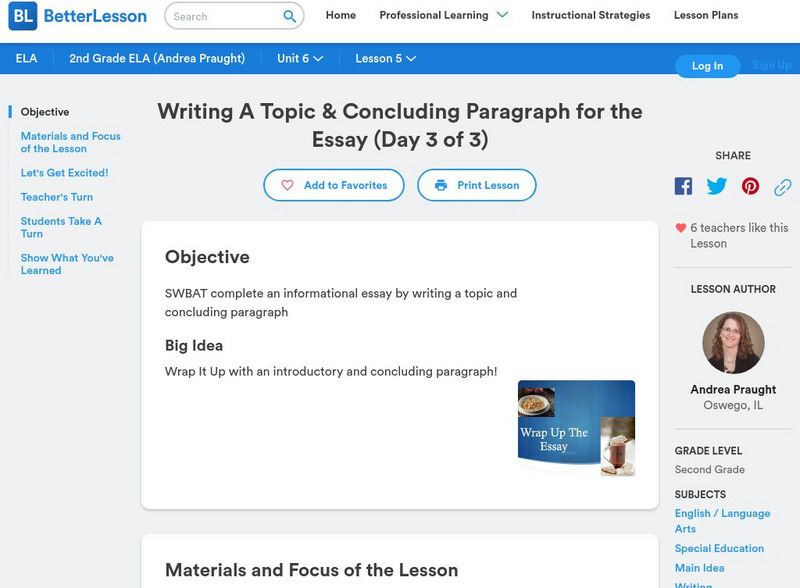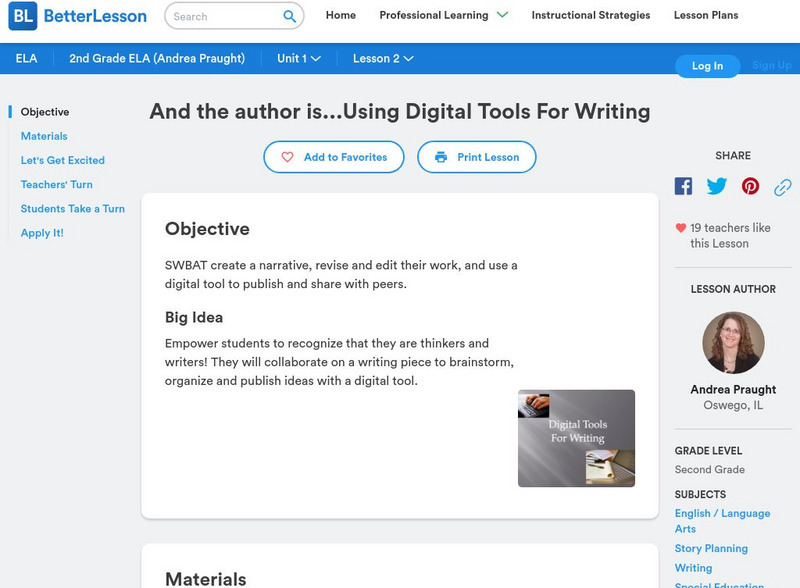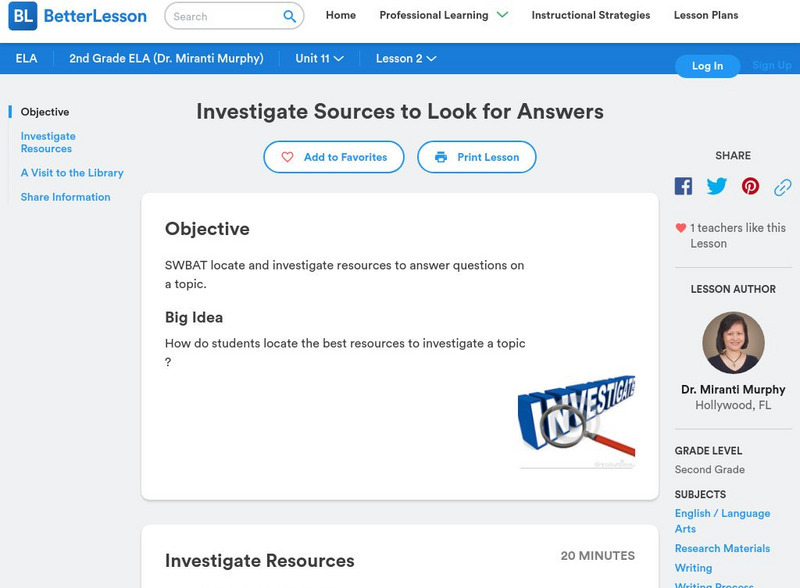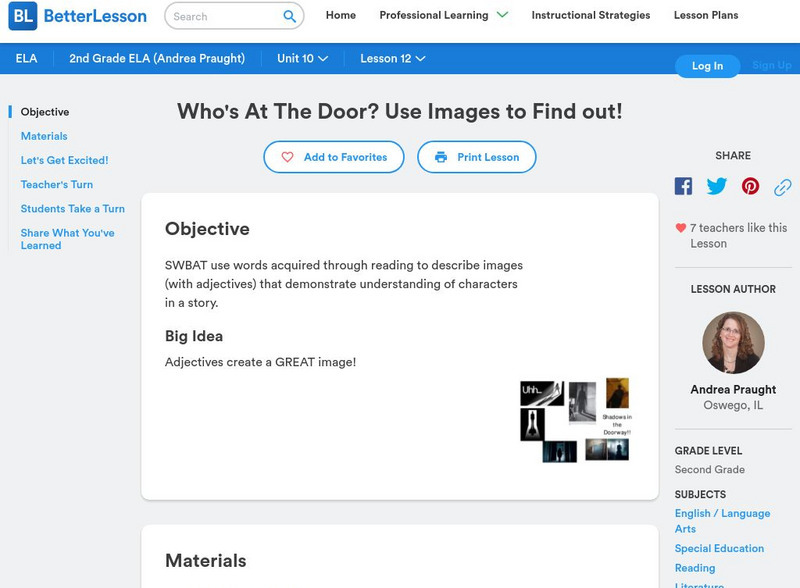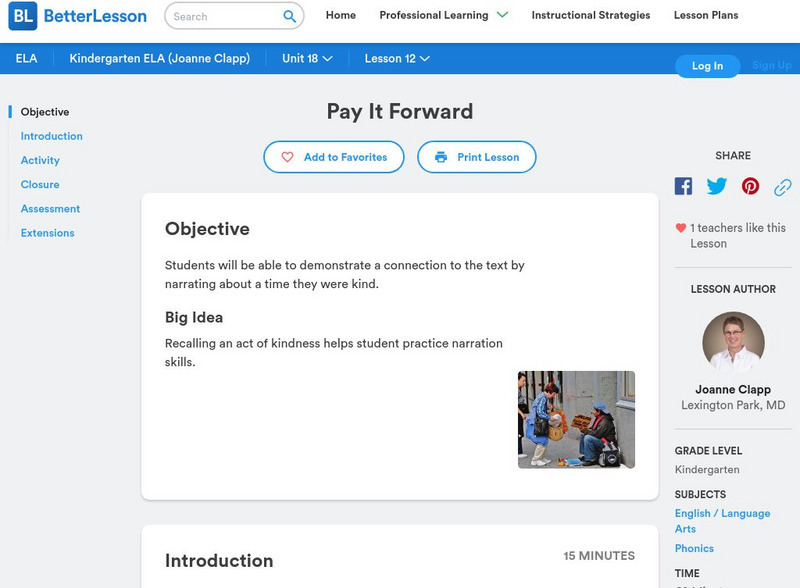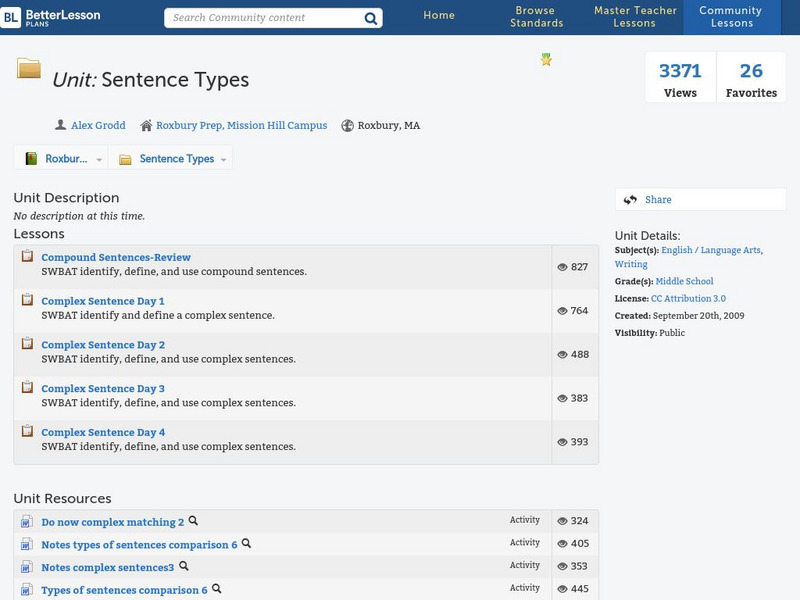Hi, what do you want to do?
Better Lesson
Better Lesson: What Shapes the Land?
In this lesson, the teacher will read a book about different landforms. The children will learn about the features of the landforms and how they were shaped by natural forces. Then text features will be discussed. The children will then...
Better Lesson
Better Lesson: Writing a Topic & Concluding Paragraph for the Essay
This lesson is a final step towards supporting students to practice writing an informative/explanatory paragraph conveying complex ideas and presenting information clearly and accurately. Second-grade students can usually write a...
Better Lesson
Better Lesson: W.2.1 Write Opinion Pieces...
Choose from a variety of lessons to help your students write an effective opinion piece.
Better Lesson
Better Lesson: And the Author Is...using Digital Tools for Writing
Empower learners to recognize that they are thinkers and writers! They will collaborate on a writing piece to brainstorm, organize and publish ideas with a digital tool. This lesson highlights different website creations as examples of...
Better Lesson
Better Lesson: Investigate Sources to Look for Answers
Learners will practice locating and investigating resources to answer questions on a topic using the FINDS research process. FINDS is an acronym describing its five-step research process: Focus, Investigate, Note, Develop, and Score. A...
Better Lesson
Better Lesson: Butterfly Bush Visitors
In this lesson, the children learn about how critters depend on the butterfly bush and how the butterfly bush, in turn, depends on it. Common Core writing skills are integrated as they take it to the next step, and create their own page...
Better Lesson
Better Lesson: The Power of Questions
Students will have the opportunity to work collaboratively by using the Think-Pair-Share technique to ask questions about a story. Included are examples of student's questions, and a Think-Pair-Share poster and document.
Better Lesson
Better Lesson: Shared Inquiry Discussion
Students learn to generate ideas with a clear focus in response to questions while participating in a shared inquiry discussion. Included are shared inquiry guidelines, and tips on discussing fiction and non-fiction books using this method.
Better Lesson
Better Lesson: Tie It Up With Transition Words to Write a Story!
Read, write, and present a digital narrative with transition words to help us put the events in order! After modeling the instructional activity, groups of students will write narratives to recount a short sequence of events, they will...
Better Lesson
Better Lesson: Go Figure With Figurative Language It Helps With Predicting!
In this lesson, students will use figurative language, digital tools, and illustrations to write a story. The teacher will model how to use an app that has onomatopoeia to create a story with a good beginning, middle, and end. A video...
Better Lesson
Better Lesson: Who's at the Door? Use Images to Find Out!
Students will use words acquired through reading to describe images (with adjectives) that demonstrate an understanding of characters in a story. The teacher will read Miss Nelson is Back which has great descriptors and will hold a class...
Better Lesson
Better Lesson: Ensuring Left to Right Reading Daily
Left to right progression is an important focus skill for kindergarteners; we really need to help our young scholars get used to working from left to right every time! This lesson is something easy you can do to remind your students to...
Better Lesson
Better Lesson: Onset Rime Segmenting and Blending
This lesson offers routines for blending and segmenting onsets and rimes of single-syllable spoken words. Included is a video showing students practicing this skill and ideas for centers.
Better Lesson
Better Lesson: Bat Versus Bird
Students compare and contrast two animals to recall learned information so they can share two facts using the informational text "The Best Nest". Included is a video explanation, a printable graphic organizer, samples of student work,...
Better Lesson
Better Lesson: Domestic vs. Wild
Sorting items help students develop language skills as they describe attributes and qualities to determine which category is the best fit for an item. The teacher will introduce the definitions of wild and domestic by reading the book...
Better Lesson
Better Lesson: With Prompting and Support, Ask and Answer Questions
Choose from a variety of lessons that meet the Common Core standard of asking and answering questions about unknown words in nonfiction texts.
Better Lesson
Better Lesson: Topic Sentences
Often, we ask students to find the main idea in the story- this helps when re-telling. Why not apply this idea to writing? Find the main idea and introduce your writing with that idea; just like with a book, it helps with re-telling!...
Better Lesson
Better Lesson: Pay It Forward
Recalling an act of kindness helps students practice narration skills. The teacher will read "Because Brian Hugged His Mother" and discuss the idea of "paying it forward" as a class. Then students will write and draw about a time when...
Better Lesson
Better Lesson: Skip Counting Patterns
Are there repeating patterns in number counting? Recording skip counts may help reveal patterns that can be used in solving later math problems.
Better Lesson
Better Lesson: Look Out Kindergarten, Here I Come!
Through the story, Look Out Kindergarten, Here I Come, students find out about Henry and his new kindergarten class. As a class, they write about what it is like in kindergarten class.
Better Lesson
Better Lesson: Have You Made Your New Year's Resolution?
By using the children's book, Squirrel's New Year's Resolution, as an example, students learn to write responses to the story and explain their own resolutions for the year. Site requires registration, but it is free.
Better Lesson
Better Lesson: Unit: Sentence Types
Lessons and materials to teach simple, compound, and complex sentences to middle school students.
Better Lesson
Better Lesson: Two Mediums, One Topic
Comparing the treatment of setting in "The Most Dangerous Game" and a movie clip. RL.9-10.7 analyze 2 media
Better Lesson
Better Lesson: The 2 Faces of Pocahontas
Teachers will engage young learners to understand how one story can be shared more than one way. This lesson demonstrates an historical interpretation of the story about Pocahontas and John Smith with the Disney movie. Several resources...






